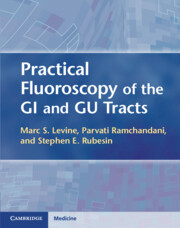Chapter 10 - Fluoroscopic evaluation of the bladder, urethra, and urinary diversions
from Section 2 - GU Tract
Published online by Cambridge University Press: 05 February 2012
Summary
Voiding cystourethrogram and cystogram
During a voiding cystourethrogram, both the bladder and the urethra are evaluated. The studies are ideally performed with real time fluoroscopic guidance. The term “cystogram” implies evaluation of the bladder alone, without the voiding phase of the examination.
Indications
Cystography and voiding cystourethrography are performed for the following indications:
Evaluation of the bladder and the male posterior urethra for leaks.
Evaluation for suspected fistulas involving the lower urinary tract.
Evaluation for vesicoureteral reflux in patients with recurrent or chronic urinary tract infections. Occasionally, evaluation for vesicoureteral reflux may be requested in patients receiving intravesical medications such as formalin for severe hemorrhagic cystitis; if vesicoureteral reflux is seen in such cases, intravesical instillation of medications may not be feasible.
Evaluation of patients with lower urinary symptoms such as difficulty in initiating voiding, incomplete voiding, incontinence, and post void dribbling.
Evaluation for suspected urethral diverticula, primarily in female patients.
- Type
- Chapter
- Information
- Practical Fluoroscopy of the GI and GU Tracts , pp. 191 - 210Publisher: Cambridge University PressPrint publication year: 2012



